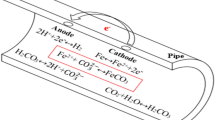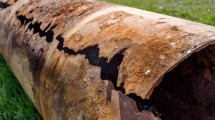Abstract
An amine based CO2 corrosion inhibitor and an imidazoline based CO2 corrosion inhibitor have been tested in a two-phase laboratory flow loop system under conditions of a gas condensate well in Austria. After a detailed description of the experimental setups, degradation rates of material API L-80 (UNS G41300) as function of flow velocity and inhibitor dosage are presented. Further, the influence of chloride addition on inhibitor performance has been investigated. All results are discussed with respect to critical inhibitor concentration to reach nearly 100 % inhibitor efficiency.
Inhibitor A exhibits alkylamine as an active ingredient dissolved in ethylene glycol and different alcohols, and the effect of inhibitor B is based on imidazoline dissolved in different alcohols. Results demonstrate that the test rig delivers reasonable results with respect to inhibitor protection rates. Independent of superficial flow velocities (tested between 3 and 35 m/s), both inhibitors exhibit a good performance as long as dosed above their critical concentration. The critical concentration is clearly below 100 ppm to the liquid phase. The addition of chlorides affects the performance of the alkylamine based inhibitor significantly more than in case of the imidazoline.
Zusammenfassung
Ein Amin-basierenender CO2-Korrosionsinhibitor und ein Imidazolin-basierender CO2-Korrosionsinhibitor wurden in einem Zweiphasen-Laborprüfsystem unter Bedingungen getestet, die einer österreichischen Gassonde entsprechen. Nach einer ausführlichen Beschreibung der Versuchsanordnung werden die Abtragsraten eines API L-80 (UNS G41300) Stahles in Abhängigkeit von Strömungsgeschwindigkeit und Inhibitordosierung gezeigt. Zusätzlich wurde der Einfluss von Chloriden auf die Inhibitorschutzwirkung untersucht. Inhibitor A enthält als Wirkstoff Alkylamin gelöst in Ethylenglykol und verschiedenene weitere Alkohole. Die Wirkung von Inhibitors B basiert auf Imidazolin als primäre Wirkkomponente. Die Ergebnisse zeigen, dass der Prüfstand mit der Praxis vergleichbare Ergebnisse hinsichtlich der Dosierung von Inhibitoren liefert. Unabhängig von der Strömungsgeschwindigkeit (getestet zwischen 3 und 35 m/s) zeigen beide Inhibitoren eine gute Schutzwirkung, so lange sie über ihrer kritischen Konzentration dosiert sind. Die kritische Konzentration liegt bei beiden deutlich unter 100 ppm. Die Zugabe von Chloriden beeinflusst die Wirkung des Amin-basierenden Inhibitors deutlich mehr als die des Imidazolin-basierenden Inhibitors.








Similar content being viewed by others
References
Lopez, D; Perez, T.: The influence of microstructure and chemical composition of carbon and low alloy steels in CO2 corrosion. A state-of-the-art appraisal, Materials & Design, 24 (2003), pp 561–575
Schmitt, G.: Fundamental aspects in CO2 corrosion, in: Corrosion 1984, Houston, TX, US, NACE, 1984, pp 10–19
Riggs, J. R. I.: Theoretical Aspects of Corrosion Inhibitors and Inhibition, in: Nathan, C. C. (Ed.), Corrosion Inhibitors, Houston, TX, US, NACE, 1994, pp 7–27
Sastri, V. S.: Corrosion Inhibitors, Principles and Applications, 1998
Hausler, R. H.; Schmitt, G. H.; Consulta, C. H.: Hydrodynamic and Flow Effects on Corrosion Inhibition, in: Corrosion 2004, Houston, TX, US, 2004, p 04402
Lopez, D. A.; Simison, S. N.; de Sanchez, S. R.: The influence of steel microstructure on CO2 corrosion. EIS studies on the inhibition effiecency of benzimidazole, Electrochimca Acta, 48 (2003), pp 845–854
Jiang, X.; Zeng, Y. G.; Ke, W.; Zheng, Y.; Effect of flow velocity and entrained sand on inhibition performances of two inhibitors for CO2 corrosion of N80 steel in 3 % NaCl solution, Corrosion Science, 47 (2005), pp 2636–2658
Paolinelli, L.; Perez, T.; Simison, S.: The effect of pre-corrosion and steel microstructure on inhibitor performance in CO2 corrosion, Corrosion Science, 50 (2008), pp 2456–2464
Heeg, B.; Klenerman, D.; Heeg, D. K. B.; Moros, T.: Persistency of Corrosion Inhibitor Films on C-steel under Multiphase Flow Conditions. Part 1: The Jet-Cylinder Arrangement, Corrosion Science, 40 (1998), pp 1303–1311
Akbar, A.; Hu, X.; Neville, A.; Wang, C.: The Influence of Flow Rate And Inhibitor On The Protective Layer Under Erosion-Corrosion Conditions Using Rotating Cylinder Electrode, in: Corrosion 2011, Houston, TX, US, NACE, 2011, pp 11274
Nesic, S.; Solvi, G. T.; Skjerve, S.: Rotating Cylinder vs. Loop Testing on Inhibitors for CO2 Corrosion, in: 8th European Symposium on Corrosion Inhibitors, Ferrara, Italy, 1995, pp 1135–1162
Hong, T.: Corrosion inhibitor studies in large flow loop at high temperature and high pressure, Corrosion Science, 43 (2001), pp 1839–1849
Altoe, P.; Pimenta, G.; Moulin, C. F.; Diaz, S. L.; Mattos, O. R.: Evaluation of oilfield corrosion inhibitors in CO2 containing media: A kinetic study, Electrochimica Acta, 41 (1996), pp 1165–1172
Canto, C.; Brown, B.; Nesic, S.: Integrity of Corrosion Inhibitor Films in Multiphase Flow, in: Corrosion 2011, Houston, TX, US, NACE, 2011, p 11238
Neville, A.; C. Wang, C.: Erosion–corrosion mitigation by corrosion inhibitors—An assessment of mechanisms, Wear, 267 (2009), pp 195–203
Sun, H.; Sujatmiko, M.; Aulia, M.; J. Davis, J.; R. Hudgins, R.: Study of Corrosion and Inhibition of Carbon Steel in CO2 Containing Natural Gas at High Temperature, in: Corrosion 2011, Houston, TX, US, NACE, 2011, p 11271
Xiong, Y.; Brown, B.; Kinsella, B.; Nesic, S.; AFM Studies of the Adhesion Properties Of Surfactant Corrosion Inhibitor Films, in: Corrosion 2013, Orlando, FL, US, NACE, 2013, pp. 2521
Vogl, T.: Investigation of the erosion corrosion behavior of carbon steels at high flow rates in the presence of inhibitors, Dissertation Montanuniv. Leoben, Chair of General and Analytical Chemistry, 2012
Author information
Authors and Affiliations
Corresponding author
Rights and permissions
About this article
Cite this article
Prethaler, A., Mori, G. & Rosenberg, E. Evaluation of Performance of an Amine Based and an Imidazoline Based Gas Condensate Inhibitor Tested with a High Velocity Laboratory Test Rig. Berg Huettenmaenn Monatsh 160, 346–351 (2015). https://doi.org/10.1007/s00501-015-0387-9
Received:
Accepted:
Published:
Issue Date:
DOI: https://doi.org/10.1007/s00501-015-0387-9




